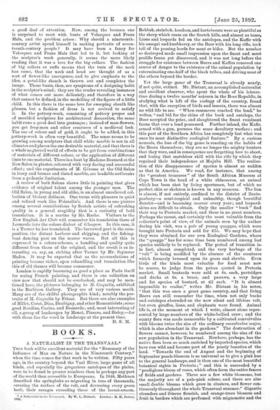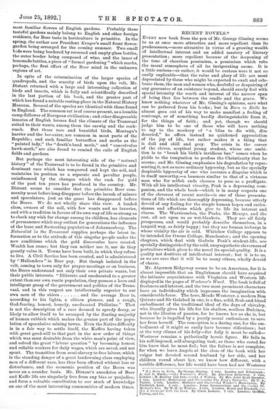BOOKS.
A NATURALIST IN THE TRANSVAAL.* Tars book will be excellent material for the " Summary of the Influence of Man on Nature in the Nineteenth Century," when the time comes for that work to be written. Fifty years ago, in the country beyond the Vaal River, large game of all kinds, and especially the gregarious antelopes of the plains, were to be found in greater numbers than in perhaps any part of the world then accessible to Europeans. In 1848, Methuen described the springboks as migrating in tens of thousands, covering the surface of the velt, and devouring every green herb, their ravages exceeding those of the locust-swarm.
1 'mod Ifafurallat in the Transvaal. By W. L. Distant. London : H. H. Porter.
Rehbok, steinbok, koodoos, and hartebeests were as plentiful as the sheep which roam on the Scotch hills, and almost as tame. Lions and leopards fed on the antelopes, and the Kaffir with his assegai and knobkerry, or the Boer with his long rifle, took toll of the passing herds for meat or hides. But the number so destroyed made small impression upon the finest and most prolific fauna yet discovered, and it was not long before the struggle for existence between Boers and Kaffirs removed one source of danger to the existence of the animal population by exterminating one-half of the black tribes, and driving most of the others beyond the border.
Yet the large game of the Transvaal is already nearly, if not quite, extinct. Mr. Distant, an accomplished naturalist and excellent observer, who spent the whole of his leisure- time during a twelve months' sojourn in the Boer Republic, in studying what is left of the zoology of the country, found that, with the exception of birds and insects, there was almost no wild life to see. " When commerce reached the land," he writes, "and bid for the skins of the buck and antelope, the Boer accepted the price, and slaughtered the finest ruminant fauna that ever a land possessed. Further inland, the Kafir, armed with a gun, pursues the same desultory warfare ; and this part of the Southern Africa has completely lost what was once its most distinctive zoological feature." By a curious nemesis, the loss of the big game is reacting on the habits of the Boers themselves; they are no longer the mighty hunters that they were, and in consequence are forgetting how to shoot, and losing that matchless skill with the rifle by which they regained their independence at Majaba Hill. The realisa- tion of this disappearance of species is almost as sudden as that in America. We read, for instance, that among the " greatest treasures " of the South African Museum at Cape Town is the head of a white rhinoceros, an animal which has been shot by living sportsmen, but of which no perfect skin or skeleton is known in any museum. The lion is almost, if not entirely, confined to the district of Zonts- panberg—a semi-tropical and unhealthy, though beautiful district—and is becoming scarcer every year ; and leopard- skins are difficult to obtain. Only the smaller " buck " find their way to Pretoria market, and these in no great numbers. Perhaps the rarest, and certainly the most valuable from the collector's point of view, of the animals seen by the author during his visit, was a pair of young quaggas, which were brought into Pretoria and sold for £55. We may hope that they were obtained for our own Zoological Gardens, where the "quagga" has for some time been numbered among lost species unlikely to be replaced. The period of transition is, in fact, almost completed, and the very herbage of the " velt " is being modified by the absence of the creatures which formerly broused upon its grass and shrubs. Even birds of the kinds most valuable for food must now be scarce, to judge from the prices quoted in Pretoria market. Small bustards were sold at Os. each, partridges and ducks at 6s. a brace, and pauuws, a very large and fat species of bustard, at £2 each. "It is almost impossible to realise," writes Mr. Distant is his notes, " that this was once a great game country, and that living Boers can still remember the time, when not only bucks and antelopes abounded on the now silent and lifeless velt, but even giraffes, lions, and elephants were found. Animal life is, at the moment at which I write, almost alone repre- sented by large numbers of the white-bellied crow; and the scanty flora was made memorable by a cultivated convolvulus with blooms twice the size of the ordinary convolvulus major, which is also abundant in the gardens." The destruction of flowers cannot, however, be numbered among the sine of the new population in the Transvaal. Nowhere, perhaps, has the native flora been so much enriched by imported species, which have run wild and become part of the yearly beauties of the land. "Towards the end of August and the beginning of September peach-blossom is so universal as to give a pink hue to the general landscape, and is then one of the most beautiful botanical sights in Pretoria ; " and this is succeeded by a "prodigious bloom of roses, which often form the entire fences of fields and gardens. There are a few white blossoms, but the majority are of a pale-pink colour, and there are also small double blooms which grow in clusters, and flower con- tinuously throughout the whole Transvaal summer." Gigantic oleanders and ibiscus flourish, and orange-trees blossom and fruit in borders which are perfumed with mignonette and the most familiar flowers of English gardens. Probably these tasteful gardens mainly belong to English and other foreign residents, for Boer taste in horticulture is primitive. In the spring, the author saw President Kruger's small front flower gardenbeing arranged for the coming summer. Two small beds were being bordered by reversed and empty glass bottles, the outer border being composed of wine, and the inner of lemonade bottles, a piece of " formal gardening " which marks, perhaps, the first effort of the Boer mind in the unknown regions of art.
In spite of the extermination of the larger species of quadrupeds, and the scarcity of birds upon the velt, Mr. Distant returned with a large and interesting collection of birds and insects, which is fully and scientifically described in the last portion of his book, and the greater part of which has found a suitable resting-place in the Natural History Museum. Several of the species are identical with those found in England. The common rat is of course present, as a humble camp-follower of European civilisation; and other disagreeable inmates of English houses find the climate of the Transvaal suited to their wants, among them the earwig and the cock- roach. But those rare and beautiful birds, Montagu's harrier and the bee-eater, are common in most parts of the Republic ; and such familiar butterflies and moths as the " painted lady," the " death's-head moth," and " convolvulus hawk-moth," are also found to remind the exile of English fields and gardens.
But perhaps the most interesting side of the "natural history" of the Transvaal is to be found in the primitive and dominant race which has conquered and kept the soil, and maintains its position as a separate and peculiar people, uninfluenced by the changes which the rush for gold of the past ten years has produced in the country. Mr. Distant seems to consider that the primitive Boer com- munity must before long disappear before the inrush of miners and speculators, just as the game has disappeared before the Boers. We do not wholly share this view. A landed class, owners of the soil, with few wants and no luxuries, and with a tradition in favour of its own way of life so strong as to check any wish for change among its children, has elements of permanence which may outlast for generations the influence of the loose and fluctuating population of Johannesberg. The Naturalist in the Transvaal supplies perhaps the latest in- formation as to the attitude of this singular people under the new conditions which the gold discoveries have created. Wealth has come; but they can neither use it, nor do they greatly value it. Towns have been built, in which they refuse to live. A Civil Service has been created, and is administered by " Hollanders " in Boer pay. But though isolated in the velt, coming to town only for prayer-meetings or on business, the Boers understand not only their own private wants, but their public interests. " Illiterate and uneducated to a greater extent than our own rustic population, they possess a keen and intelligent grasp of the government and politics of the Trans- vaal, and in this respect are intellectually superior to our own men of the shires and the average Boer is, according to his lights, a citizen pioneer, and a rough, God-fearing, honest, homely, uneducated Philistine." That is not the description of a race doomed to speedy decay, or likely to allow itself to be swamped by the floating majority of human rubbish which makes the greater part of the popu- lation of speculative mining towns. Even the Native difficulty is in a fair way to settle itself, the Kaffirs having taken with great good-will to that part in the new order of things which was most desirable from the white man's point of view, and solved the great "labour question" by becoming honest and reliable workers for daily wages, which are saved, and not spent. The transition from semi-slavery to free labour, which is the standing danger of a great landowning class employing men of a different race, has thus been effected without loss or disturbance, and the economic position of the Boers was never on a sounder basis. Mr. Distant's anecdotes of Boer and Kaffir life are singularly free from any bias or prejudice, and form a valuable contribution to our stock of knowledge on one of the most interesting communities of modern times.



































 Previous page
Previous page